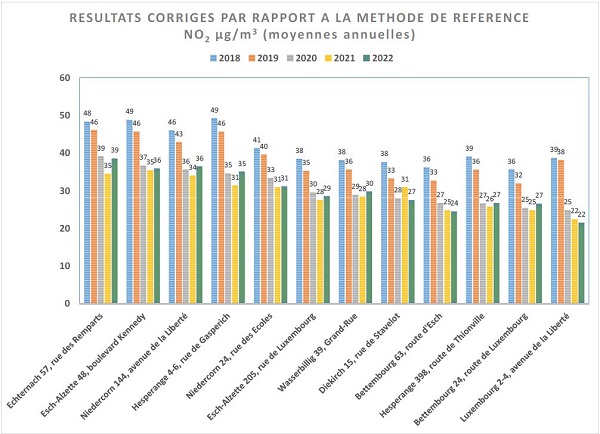 Comparison of NO2 levels between 2018 and 2022;
Credit: AEV
Comparison of NO2 levels between 2018 and 2022;
Credit: AEV
The Environment Agency of Luxembourg's Ministry of the Environment, Climate and Sustainable Development has presented the results of the 2022 nitrogen dioxide (NO2) measurement campaign.
As part of the "climate pact" (Klimapakt), the Environment Agency, together with the municipalities and the Klima-Agence, carried out the fifth nitrogen dioxide (NO2) measurement campaign from 5 January to 21 December 2022. In total, the presence of the pollutant was measured at 112 sites in 33 municipalities.
In 2022, no location exceeded the limit value of 40 µg/m3. A few locations showed values very close to the limit value, notably in Remich, Echternach and Differdange, but also in Esch-sur-Alzette, Hesperange and Luxembourg City.
The Environment Agency noted that even if everything is currently compliant from a regulatory point of view, efforts to reduce air pollution must continue in collaboration with the municipalities.
The Environment Agency recalled that slightly higher NO2 concentrations are observed generally during the winter months due to emissions from heating systems, with winter weather conditions making it more difficult for air pollutants to escape. The high levels observed during the month of March 2022 coincided with three episodes of PM10 fine particle peaks. These days were marked by dry and sunny weather with weak winds and temperature inversion effects resulting in poor dispersion of atmospheric pollutants.
The low level observed during the first half of August 2022 has been attributed to the general drop in road traffic in summer. Moreover, during the summer period, better air mixing and photochemical degradation reactions by ozone generally lead to a decrease in NO2 concentrations.
Since 2018, there has been a gradual decline in annual averages, with a particularly pronounced drop in 2020 and 2021, linked to the measures put in place during the COVID-19 pandemic, according to the Environment Agency.
In 2022, most of the averages had returned to 2020 levels. The reduction of emissions from road traffic by modernising the vehicle fleet with the progress of new EURO standards and electric vehicles was partly hampered by a general increase in road traffic which resumed in 2022.
In addition, unfavourable weather conditions for air quality in 2022, especially in March, may be partly responsible for the slight increase in averages.
According to the Environment Agency, the main objectives of the measurement campaign are to raise the awareness of municipalities and their inhabitants about air quality with regard to the pollutant NO2 and to motivate them to contribute to improving air quality. The measurements are also used as follows: to better inform citizens; to take stock of the situation in order to be able to subsequently quantify and communicate the impact of the efforts undertaken to improve air quality; to complete and refine the measurements and modeling of the Environment Agency on the geographical distribution of NO2 levels throughout the Grand Duchy; to identify new locations which exceed (hotspots) or risk exceeding (critical points) the limit value; to compare the results at national level by organising a joint campaign.
In terms of the method used, in order to determine the NO2 concentration, samples are collected every two weeks using passive diffusion tubes. Passive sampling consists of exposing adsorbent tubes to the open air for a fixed period at a height of about 3 m. By simple diffusion of the pollutant present in the air, it will be trapped by the sampler. The samples are then analysed in the laboratory by spectrophotometry.








